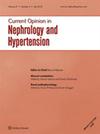International equity in access to home dialysis.
IF 2.4
3区 医学
Q3 PERIPHERAL VASCULAR DISEASE
Current Opinion in Nephrology and Hypertension
Pub Date : 2024-09-13
DOI:10.1097/mnh.0000000000001027
引用次数: 0
Abstract
PURPOSE OF REVIEW Discussion of inequalities and inequities in global distribution of and access to home dialysis. RECENT FINDINGS The majority of patients receiving home dialysis receive peritoneal dialysis, but these are concentrated in few countries across the globe. Peritoneal dialysis as the most common form of home dialysis has many advantages in terms of individual freedoms, similar outcomes to haemodialysis, being less costly in some countries, and more scalable than in-centre haemodialysis. Despite this there are many inequities in access at the patient, clinician, health system and geopolitical levels. Poverty, discrimination and lack of support at home are important drivers of inequities at the patient level. At the clinician and health systems level lack of experience in home dialysis, lack of resources and lack of time drive patients towards in-centre dialysis. At the geopolitical level, high costs associated with procurement and distribution of peritoneal dialysis solutions exacerbate inequities in access. SUMMARY The challenge of reducing global inequities in access to home dialysis in low- and middle-income countries are vast and would require training of the doctors, nurses, families, patients, leaders and community partners. Once this is achieved, dealing with costs and logistics of supplies is crucial to improve and sustain equitable access.家庭透析的国际公平性。
综述目的讨论家庭透析在全球分布和获取方面的不平等和不公平现象。最新发现大多数接受家庭透析的患者都接受腹膜透析,但这些患者主要集中在全球少数几个国家。腹膜透析是最常见的家庭透析方式,具有许多优点,如个人自由、与血液透析结果相似、在一些国家费用较低、比中心血液透析更易推广等。尽管如此,在患者、临床医生、医疗系统和地缘政治层面,仍存在许多不公平现象。贫困、歧视和缺乏家庭支持是造成患者层面不平等的重要原因。在临床医生和医疗系统层面,家庭透析经验的缺乏、资源的匮乏和时间的不足促使患者选择中心透析。在地缘政治层面,与腹膜透析解决方案的采购和分配相关的高昂成本加剧了就诊机会的不平等。总结 在低收入和中等收入国家,减少全球家庭透析就诊机会不平等的挑战是巨大的,需要对医生、护士、家庭、患者、领导者和社区合作伙伴进行培训。一旦实现了这一目标,处理好成本和供应品的物流问题对于改善和维持公平获取至关重要。
本文章由计算机程序翻译,如有差异,请以英文原文为准。
求助全文
约1分钟内获得全文
求助全文
来源期刊
CiteScore
5.70
自引率
6.20%
发文量
132
审稿时长
6-12 weeks
期刊介绍:
A reader-friendly resource, Current Opinion in Nephrology and Hypertension provides an up-to-date account of the most important advances in the field of nephrology and hypertension. Each issue contains either two or three sections delivering a diverse and comprehensive coverage of all the key issues, including pathophysiology of hypertension, circulation and hemodynamics, and clinical nephrology. Current Opinion in Nephrology and Hypertension is an indispensable journal for the busy clinician, researcher or student.

 求助内容:
求助内容: 应助结果提醒方式:
应助结果提醒方式:


